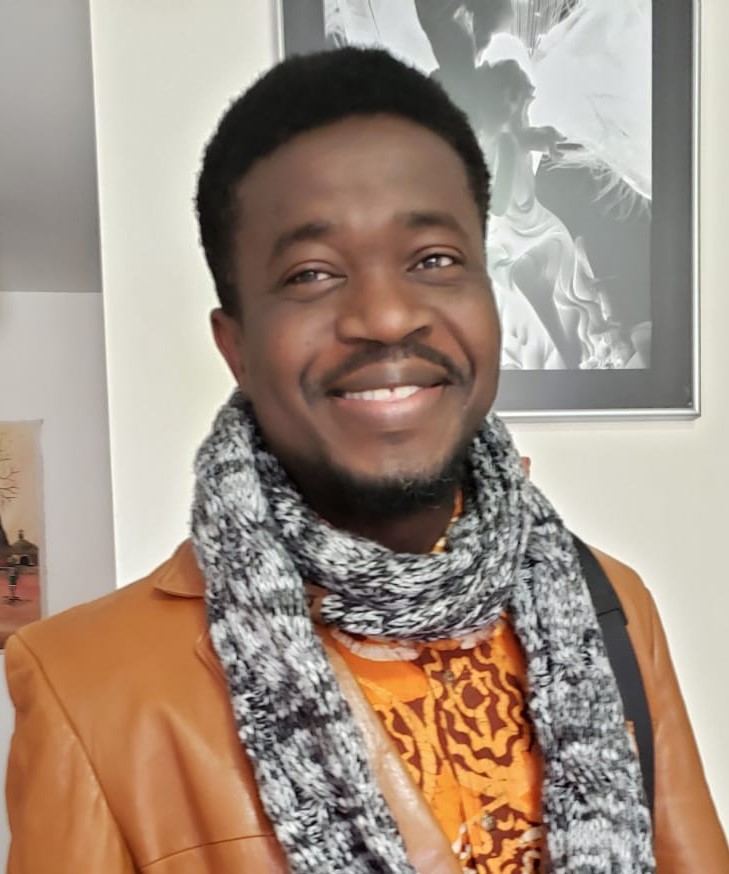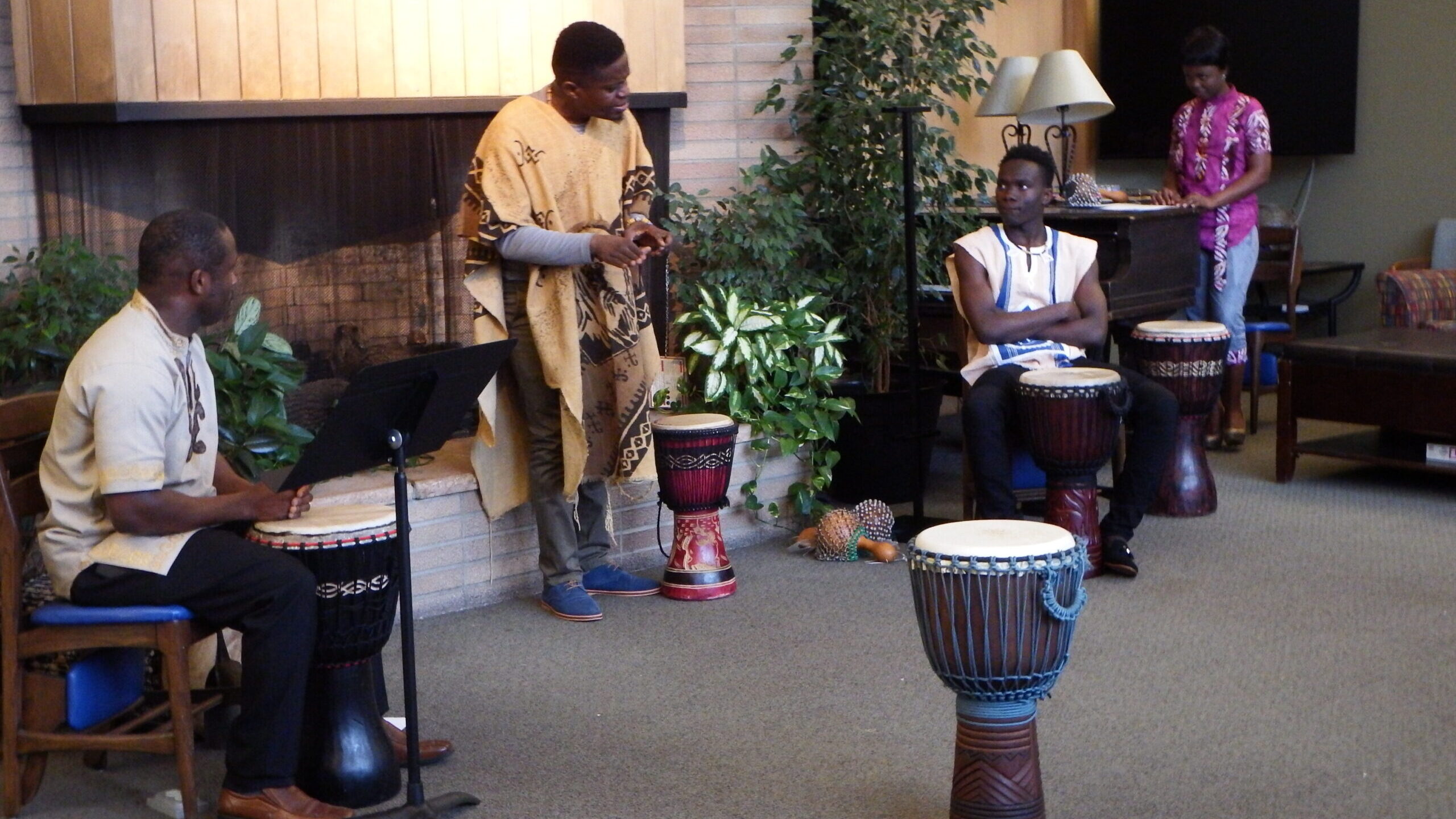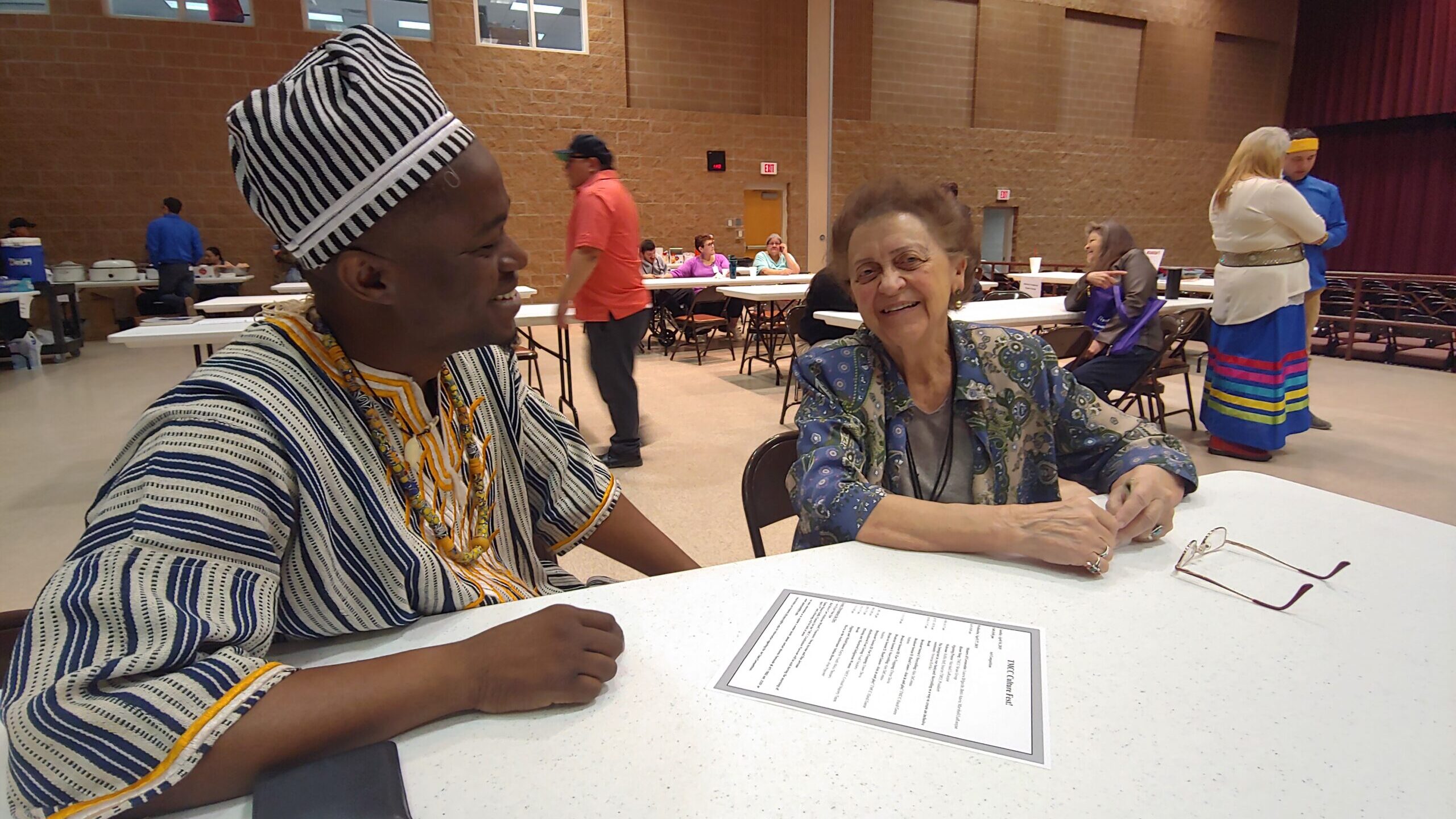
Hailing from Lomé, Togo, Hamzat’s firsthand experience as an immigrant navigating American culture heavily informs the work he does with the African Arts Arena, an arts organization that provides opportunities for both African-Americans and new Americans of African heritage to celebrate and share their culture.
The New American in Your Backyard program, one of the organization’s biggest ventures, heavily focuses on the celebration of African culture through storytelling; programming consists of performances based on community members’ lived experience, and takes place throughout the community in places like schools, local institutions, and even private homes. As the immigrant population continues to grow in Hamzat’s community of Grand Forks, the work he’s doing to hold space for these conversations becomes more and more important to help preserve the stories of the African community within his town.
How did you come up with the idea for the New American in Your Backyard program?
The idea came out of frustration—frustration about the fact that we have these other people who usually take all of the oxygen in the room when it comes to talking about new American immigrants or refugees. I looked around, and all the trainings, all the big conferences, all the household-name speakers that are trying to solve the issue, it just seems like as immigrants—as new Americans, or refugees, or foreign-born—we are being left out of the conversation.
Sometimes people who call themself allies just assume this is what we want, for them to speak on our behalf. I know there might be some good intention behind it, but it kind of frustrates me. So instead of just sitting there and complaining as we love doing, I decided to do something with my organization, the African Arts Arena. The question was, how can I get involved in this conversation, not from the fact that I’m a PhD or I’m a university teacher, but just as an immigrant; a new American who wanted to say, okay, hold on, let me tell my story from both sides.
DR. HAMZAT KORIKOWhen human beings cannot talk to each other anymore,
the only language that we understand is art.
How has your lived experience as an immigrant affected the way that you set up the program?
One of the most effective ways of connecting with other human beings, maybe who are not from the same cultural background or who don’t have the same lived experience, is through story. Growing up, my grandma and my grandpa, if they wanted to give us some advice, they would use a fairy tale or folk tale. So I thought, why not take that approach? Instead of going to people and telling them what they’re doing is or isn’t right, you just tell your story as another human being, and then people get to ask their own questions. That lived experience as somebody growing up in Togo, I took and thought, “Maybe I can use that here.”
That’s how I decided that I was going to use a non-confrontational approach to talk about issues that are dear to us, because before being immigrants or before being new Americans, we are first people of color. These are the things that I try to bring into the conversation; sometimes I can use the real life experience, and sometimes I can just use fairytales as a pretext to engage those discussions.
Why do you think that art is so effective in helping bridge differences between communities?
When human beings cannot talk to each other anymore, the only language that we understand is art. Once you put it out there, people look at it and then they see you, and then you can easily engage people and talk about difficult subjects like immigration, like race in America, or the responsibility of an ally. I always see art as a universal language.
How has the Grand Forks community responded to the New American in Your Backyard program?
The Grand Forks community is very supportive! For instance, the first time I came up with the idea, I worked with a church on campus at the University of North Dakota. They quickly said, “Well, Hamzat, you know what? We love the concept, would you mind coming to our church and starting it?” So the first time I did the New American in Your Backyard was at Christus Rex, which is a small church near the University of North Dakota, and after that other people sent in some requests to do it with them.
Now that we’re talking about it, I have a friend; his name is Paul, he sees himself as a conservative Republican, and he loves having coffee with me every Friday. It makes me think, “Oh, my God, what if I didn’t put myself out there and start talking?” He saw something in me that just makes him feel like, “Here is another human being I can learn from, and he can learn from me.” And he always comes to all the events that I organize, right? So for me, that’s exactly the response that I’m hoping to get from the community.

What has surprised you about working with the New American in Your Backyard program?
Well, the willingness of the immigrant community to have a feeling like, “Oh, my God. I can just go out there and tell my story, actually, I can come out and talk about my pain. There is work that we’re doing with the City of Grand Forks who reached out to me and said, “There are some youth in the immigrant community who are feeling some pain, would you mind working with them?” I said, “Sure.” The idea was, can you create a space where they can come in and tell their story? And those stories are stories that I wouldn’t have thought about, like the immigrant youth struggling with drugs, the immigrant youth struggling… We just couldn’t see that because as an immigrant community, we felt like, “Well, these are not things that we do. Therefore, it doesn’t exist.” But that was not true.
Out of The New American in Your Backyard, we branched into another project, which is all about creating a space to tell a story, and share that story with community members; then, the community members are going to connect with each of us as human beings, not as immigrants.
Have you noticed any differences in outlook between the older and younger generations of immigrants?
Yes. There is this generational struggle between the youth and the older generation who wanted to stick to their culture. But the new generation, even though they are born here and grow up here, they’re still seen as immigrants and some sort of extension from their parents that they just cannot escape. Then you have a situation where a kid is feeling pain, feeling lonely cannot go to the parents and talk to them about it because there’s this culture that we don’t do that. You have a group of young people who cannot go and talk about mental health issues because as immigrants, there is no such thing.
There was this one really moving session that we had once where a young woman, I think from East Asia, started talking about that struggle openly in front of everybody. Her father was on the call, but she didn’t know, but when she started talking, we could see the face of the father seem to say something like, “Oh, my God. I didn’t really know this thing was happening to my daughter.” And the way this young woman spoke about her pain, it was blameless to the parent. There was no accusation of my father, my mother didn’t do this or that. No, she spoke as if she had lived 50 years. It was right to the point and for that, we all were really grateful because she laid the ground for the work that we wanted to do in the future.
DR. HAMZAT KORIKOThe community members are going to connect with each of us
as human beings, not as immigrants.
What does being an immigrant mean to you and your identity?
It can seem like a burden because when you wake up and you get out there in the community, you just want to be another community member who wants to contribute; who wants to make mistakes and grow out of it; to just be a human being. But being an immigrant, you have a lot of boxes to check, and then you always want to make sure that you live by those boxes so that you don’t bring shame to the immigrant community. It becomes really hard to just be oneself, to just be another human being.
On top of that, if you’re an immigrant, a new American and you are a person of color, it makes the weight even heavier because at the same time a group of people are not seeing you as fully American. They are also quick to push you into a specific group so that they can make a case out of it. You cannot have this identity turmoil that you have to navigate, negotiate every day, and sometimes if you’re not careful, you’re just going to find yourself static.
How has African Arts Arena navigated your work during the pandemic?
The pandemic was more of a wake-up call for us; it allowed us to reflect more on who we are as an organization and who we should put on our board because people on our board have to understand our mission, which is not just to do art, but to preserve aspects of our culture. We learned a lot through that, along with still doing a little bit of art creation; our organization, they’re not just there to entertain people, as we’re also trying to bring in some of our cultural backgrounds. Having the right people is very, very helpful to keep your organization going even through a difficult time like the pandemic, and I have to thank my board members who were there with the advice, all those commenting to keep us going.
And the other thing is, I personally know that I’m learning more and more about how to stand for myself, how to try to be just a human being because we can only be “just immigrants” for so long, even though we will be immigrants on the land of the Native American forever. We cannot just let other people define us as immigrants and try to live up to their sets of definitions.
African Arts Arena is a United States Regional Arts Resilience Fund recipient. Check out our History for more information about this program. Thanks to the Mellon Foundation and an anonymous donor for their support of African Arts Arena and other Midwestern arts organizations.
